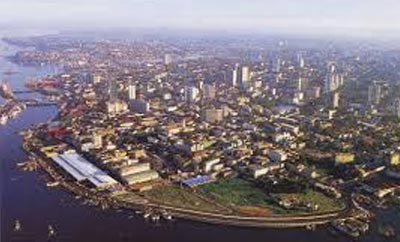Both the England and United States soccer teams are set to play World Cup matches in the steamy Amazon city of Manaus in north Brazil, where two notorious drug gangs are slugging it out for control of cocaine trafficking routes.
Ahead of the World Cup, private news agency Southern Pulse have produced a series of reports on the Brazilian cities that will play host to the tournament, looking at the organized crime presence, security dynamics and assessing risks. The excerpts below from their security briefing on Manaus examine the threat from organized crime. The full report is available for purchase here.
In honor of the World Cup, InSight Crime is chronicling how soccer and organized crime intersect. See other stories here.
Manaus is the center for everything one might expect of a transportation hub, encompassing both licit and illicit merchandise. The city is home to factories that assemble TVs, motorcycles, cellular phones and other products, all purchasable with tax incentives in the city. Manaus is also the main transportation hub for a network of drugs traffickers that begin in Colombia and Peru and deliver product to Europe as well as other parts of Brazil.
[…]
Two main groups dispute the control of the Manaus criminal environment: the First Capital Command (PCC), which according to SPC sources with links to federal law enforcement is pushing in from the state of Roraima to the north, and the Family of the North (FDN).
The PCC is a tier one criminal organization based in São Paulo with influence throughout Brazil. They are the dominant criminal organization in the Brazilian prison system, especially in São Paulo, and have ties to a loose network of criminals with entrepreneurial spirit. In Manaus, the PCC maintains partial control over select prisons such as Instituto Penal Antônio Trindade (Ipat), and compete with the FDN over control of the city. The most visible manifestation of their rivalry occurs when they use prison riots to attack each other. The PCC knows that control over the prison system gives them leverage over their rivals in managing the city’s criminal environment. For their part, the FDN seeks to keep its foothold and actively hunts down PCC leaders on the streets of Manaus.
SEE ALSO: First Capital Command Profile
The FDN is a tier two criminal organization formed under the tutorship of tier one group the Red Command (CV). Three men lead the FDN: Roberto Fernandes, aka Ze Roberto da Compensa; Gelson Carnauba; and Joao Pinto Carioca, aka Joao Branco. The first two are serving sentences in jail at Catanduvas Federal Prison while Joao Branco is serving his sentence at the Complexo Penitenciario Anisio Jobim (Compaj) in Manaus. Their incarceration does not impede their governance over FDN operations outside prison walls.
The FDN organizes itself by dividing Manaus territorially, to avoid conflict and better govern the city’s criminal underworld. Their association with CV started in the early 2000s, when Amazonian drug dealers in a federal prison in Mato Grosso networked with Fernandinho Beira-Mar (a CV strongman), who was serving his sentence in the same place. Inmates’ family members living in the city where the prison was located started to exchange information, conducting criminal technology transfer with the family members of the Amazonian inmates.
Meanwhile, the CV actively set up a base of operations in Manaus to support their drugs and weapons imports from the Revolutionary Armed Forces of Colombia (FARC), a Colombian insurgency deeply involved in the drugs trade. As part of their relationship with CV, the FDN is currently resisting PCC encroachment, using its local dominance to resist the outsider group.
SEE ALSO: Red Command Profile
Part of FDN’s power originates in the Amazonas state prison system, which it controls with few exceptions (such as Ipat), but another part originates in their territorial control over the distribution and retail of drugs throughout Manaus and more broadly, over much of north Brazil. Two of the FDN’s headmen, Ze Roberto da Compensa and Joao Branco are in charge of two of the city’s main problem areas, the neighborhood of Compensa (near the Rio Negro Bridge and on the Rio Negro shoreline) and Mauazinho (another shoreline neighborhood in Manaus’s East Zone). From these locations, the group controls distribution to local tier three criminal groups throughout the city and operates drug retail centers in the North Zone of the city, like Cidade Nova./p>
As Southern Pulse has witnessed in other countries in Latin America, tier three criminal groups tend to perpetrate violence recorded at the street level, throughout the city. These groups are indistinguishable, blend into the city’s population, and attract no special attention from the media individually, except for police raids. Mainly, these are very small operations.
In Manaus, public security analysts link approximately 70 percent of homicides to small-scale trafficking, most of which occur due to turf wars between these tier three groups who fight over retail locations and perform executions to settle debts incurred by consumers. Multiple Southern Pulse sources linked to law enforcement, local media and public security political appointees indicated that the drugs trade drives most crime in Manaus because it fuels the retail sales and consumption cycles of violence inherent to tier three activity.
[…]
Visitors should be aware of this, but not be afraid of the city and its dynamics. Popular culture describes the city’s residents — Manauaras — as friendly and peaceful. Although thefts and robberies do occur, they are no more common than in any large city. Quintessentially, Manaus is the metropolis of northern Brazil.
*Excerpts reprinted with permission from Southern Pulse. The full report is available here.
In honor of the World Cup, InSight Crime is chronicling how soccer and organized crime intersect. See other stories here.

